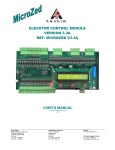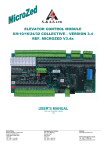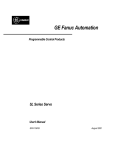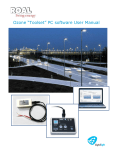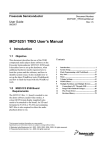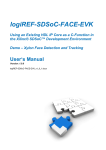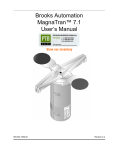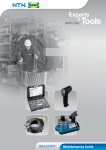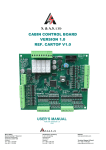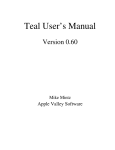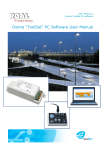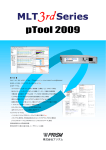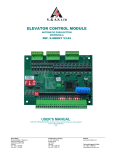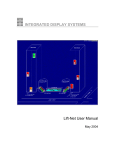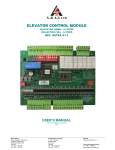Download USER`S MANUAL S. & A.S. LTD
Transcript
S. & A.S. LTD ELEVATOR CONTROL MODULE VERSION 3.5 REF. MICROZED V3.5 USER’S MANUAL FOR S/W VERSION 1.00 1511 Beirut Office: Boutros Building 1st Basement Cheikh-el-Ghabi Street Ghabi Beirut 2068 7808 Lebanon Tel: +961 1 216 994 Fax:+961 1 339 600 Headquarters & Factory: S. & A. S. Building Seaside Road Jieh Chouf Lebanon Tel: +961 7 996 333 Fax:+961 7 996 116 Website: www.sascontrollers.com Technical Support & Email: Tel: +961 71 996 333 [email protected] 1 GENERAL DESCRIPTION 3 MAIN FEATURES..................................................................................................................................................... 3 1.2 TECHNICAL DATA ................................................................................................................................................... 4 2 TERMINAL DESCRIPTION 5 2.1 TERMINAL LAYOUT ................................................................................................................................................ 5 2.2 INPUT TERMINALS ................................................................................................................................................. 5 2.3 OUTPUT TERMINALS ............................................................................................................................................. 6 2.3.1 OUTPUT TERMINALS FOR AC 1 SPEED AND AC 2 SPEED ....................................................................... 6 2.3.2 OUTPUT TERMINALS FOR VVVF ................................................................................................................... 6 2.3.3 OUTPUT TERMINALS FOR HYDRAULIC ....................................................................................................... 6 2.3.4 INDICATOR OUTPUT TERMINALS .................................................................................................................. 7 2.4 INCREMENTAL ENCODER TERMINALS ............................................................................................................... 7 2.5 CALL TERMINALS ................................................................................................................................................... 7 2.5.1 CALL TERMINALS LOCATED ON BOARD ..................................................................................................... 7 2.5.2 CALL TERMINALS ON EXTENSION BOARDS ............................................................................................... 8 2.6 COMMUNICATION TERMINALS CONNECTION ................................................................................................. 11 3 CONTENTS OF PAGES DISPLAYED ON LCD 12 4 VIEWING FAULTS AND FAULTS DESCRIPTION 12 4.1 HOW TO VIEW THE FAULTS ............................................................................................................................... 12 4.2 HOW TO ERASE THE FAULTS ............................................................................................................................ 12 4.3 FAULT CODE DESCRIPTION ............................................................................................................................... 13 5 MENU 14 5.1 PASSWORD ........................................................................................................................................................... 14 5.2 ACCESSING THE MENU....................................................................................................................................... 14 5.3 MENU DESCRIPTION ........................................................................................................................................... 15 5.3.1 MENU TRANSLATION INTO FRENCH AND ARABIC .................................................................................. 21 5.3.2 ON-BOARD CALL REGISTRATION FUNCTION ........................................................................................... 22 5.3.3 ON-BOARD INSPECTION OPERATION ....................................................................................................... 22 5.3.4 CARCALL CANCELLATION ........................................................................................................................... 22 5.3.5 DOOR MAPPING FOR TWO DOOR ENTRANCE ......................................................................................... 23 6 DIP SWITCHES FUNCTION DESCRIPTION 23 7 IMPLEMENTAION OF DIRECT APPROACH (USING ENCODER) 23 7.1 ELEVATOR INSTALLATION .................................................................................................................................. 23 7.2 SETTINGS IN THE MAIN MENU ........................................................................................................................... 23 7.3 LEARNING TRIP PROCEDURE ............................................................................................................................ 23 7.4 DISTANCE CALCULATION ................................................................................................................................... 24 8 MANUAL FLOOR ADJUSTMENT 24 9 DESKTOP FIRMWARE UPGRADE 25 9.1 INSTALLING THE MZ3.5 FIRMWARE UPGRADE SOFTWARE ......................................................................... 25 9.2 INSTALLING THE MZ3.5 USB DRIVER ................................................................................................................ 25 9.2.1 DRIVER SETUP FOR WINDOWS VISTA/WIN7 ............................................................................................ 25 9.2.2 DRIVER SETUP FOR WINDOWS XP ............................................................................................................ 27 9.3 FIRMWARE UPGRADE PROCESS ...................................................................................................................... 28 10 GOOGLE STORE FIRMWARE UPGRADE 30 10.1 INSTALLING THE SASPTOOL FIRMWARE APPLICATION ON THE MOBILE .................................................. 30 10.2 FIRMWARE UPGRADE PROCESS ...................................................................................................................... 30 11 APPENDIX A 32 2 1 GENERAL DESCRIPTION The MicroZed v3.5 elevator controller module contains all the necessary components to control the elevator and to simultaneously insure the protection of the elevator and user against faulty conditions. It can operate in a group of up to 4 elevators. In addition, this module has a user-friendly interface consisting of one 24-characters by 2-lines LCD alphanumeric display and three push buttons to access the different pages, menus and parameters editing (the display is sold separately). The outputs are capable of driving both AC and DC contactors. Controller has an incremental encoder interface used optionally for floor information (Slow down and final stop). All spare outputs are user configurable. In call multiplexing mode, the controller can service up to 16 floors in down collective simplex. The firmware could be upgraded on site. Furthermore, the MicroZed v3.5 controller has a serial RS485 port enabling it to be connected to a hand held diagnostic tool (sold separately). A new optional CAN bus port is available for serial calls. A new optional interface call is available and it has a USB port, an ethernet port for internet connection and an RS232 port for a GSM modem connection. 1.1 MAIN FEATURES Platform Type Mode Self diagnostic Status information Fault count Shaft information Indicator signal Number of stops Door type Door controls5 Door parking status Floor Stop time Main landing Car light Automatic return Gong output Inspection mode7 Reservation8 Minimum load1 Full load9 Emergency stop Firemen operation10 Terminals Group operation Communication Software Carcall cancellation Firmware update ARM Microcontroller AC 1 speed – AC 2 speed – VVVF – Hydraulic1 Simplex or group1 Fault messages describing common faults related to periphery inputs Status of the elevator and the door are permanently displayed Count of level II faults (refer to section 4.1) is permanently displayed End of shaft in the up direction End of shaft in the down direction Slow down and final stop in the up direction Slow down and final stop in the down direction Door zone (recommended but not obligatory) Car position is saved following a power failure2 Gray code, provided by the board (binary or other types can be supported optionally) 8, 163, 243 or 323 stops collective down – 6, 113, 163 or 223 stops collective selective1 – 16 stops collective Mul4, 9 stops collective MulF4 Swinging, automatic or ½ automatic door1 Input for re-open, photocell and door jam switch + input to bypass closing delay6 Parking with door opened or door closed1 Can be defined by the user1 Can be defined as any stop1 Automatic switch off after preset time To main landing floor Three seconds pulse to signal the arrival of the elevator For installation and maintenance purposes using slow speed/ Inspection speed System responds to car calls only, outside calls are canceled Car calls are canceled if car stops twice on a car call and no passengers exit car Only car calls are served, outside calls are still registered Car is stopped, car calls canceled, outside calls retained, car restarts on a car call Evacuation to ground floor, blocking all calls and allowing firemen operation All terminals are individually labeled according to function to facilitate identification RS485 port ready for group operation Optional board (MCI-HUB) available for remote monitoring and control directly by PC or by internet. Connection via Ethernet or via RS232 GSM modem. Monitoring and controlling elevator installation, software runs under WindowsTM A registered carcall cancelled when user double-clicks it User desktop interface to upgrade firmware on site Google store Application: SASPTool 1 Selection by presetting a parameter in the menu, refer to section 5. When power returns, elevator resumes from where it was without the need of a homing trip unless Power-ON homing is enabled, refer to section 5. 3 Requires optional extension boards. 4 Requires no extension and the elevator must not in group mode. 5 For automatic or ½ automatic door only. 6 Activated by a push button in the car. 7 Activated by an external key switch and two push buttons. 8 Activated by a key switch in the car. 9 Activated by an external contact. 10 Activated by a key switch in the main landing floor. 2 3 1.2 TECHNICAL DATA Supply voltages Inputs Control outputs Spare outputs Call terminals Indicator outputs Connection 1 Board supply: 17vac +15% -25% - 120mA Periphery supply: 22vdc +15% -25% Each input has a led to indicate its status – all inputs are optically isolated Input active voltage level is 22vdc Each output has a led to indicate its status – all outputs are dry relay contacts Rated at 250Vac 10A1 Each output has a led to indicate its status – all outputs are optically isolated Output voltage level is 0vdc (GND) when active Each call has a led to indicate its status Each call terminal consists of a combined input/output which is optically isolated Call active voltage level is zero volts (GND) Call terminals are capable of driving lamps up to 3 watts operating on 22vdc Each call terminal is protected by an additional output transistor The + and – supplies of Car and Hall are short circuit protected Each output has a led to indicate its status – all outputs are optically isolated For A,B,C,D,E, LED On: Output voltage level is 22vdc (P) For arrow up and arrow down LED On: Output voltage level is 0vdc (GND) Screw type, plug-in connectors Care should be taken to add a freewheeling diode in parallel with the coil of each DC contactor or DC relay driven from the board. 4 TERMINAL DESCRIPTION 2.2 CT3 CT2 CT1 CT0 17V~ 17V~ CT9 CT8 CT7 CT6 CT5 CT4 CT15 CT14 CT13 CT12 CT11 CT10 P GND + HALL - HALL + CAR - CAR B A COM DATA1 DATA2 EOS DN1 EOS UP1 IP2 IP3 PTC b PTC a SPRE IP1 FRMN DZ VVVF BR FULL LS EC LS EO CLSE RE OPN SFTY ON CONT RDY STP RSV INSP EN INPUT TERMINALS SDFS UP SDFS DN EOS UP EOS DN INSP UP INSP DN INSP EN RSV STP CONT RDY SFTY ON RE OPN CLSE LS EO LS EC FULL VVVF BR DZ FRMN SPRE IP1 PTC a PTC b IP2 IP3 EOS UP1 EOS DN1 1 INSP DN INSP UP EOS DN EOS UP SDPF DN SDFS UP -5V + AA+ BB+ LOW HI UP DN SOP1 SOP2 ↓↑ E D C TERMINAL LAYOUT LGHT CLGT OPN CLSE CDOOR CDRV 2.1 SOP3 SOP4 2 Slow down and final stop in the up direction magnetic switch/ Zero speed reached in VVVF1 Slow down and final stop in the down direction magnetic switch End of shaft in the up direction magnetic or limit switch to force slow speed End of shaft in the down direction magnetic or limit switch to force slow speed Inspection up Inspection down Inspection enable (when input is inactive) Reservation – outside calls are canceled (when input is active) Emergency stop (when input is inactive) Should be active prior to initiating travel (ensures that all contactors are in their OFF state) Should be active when lift is moving (used to read the status of the safety circuit) Re-open for automatic door (when inactive) / door closed for swinging door (when active) Bypasses reclosing delay in automatic door Limit switch end of opening Limit switch end of closing Full load – only car calls are served with outside calls still being registered (when input is active) A VVVF signal that prompts the controller that the drive has engaged the mechanical brake Door zone magnetic switch Firemen switch VVVF error Input from the PTC Input from the PTC Evacuation input Overload End of shaft in the up direction magnetic or limit switch to force intermediate speed End of shaft in the down direction magnetic or limit switch to force intermediate speed Used in direct approach mode with VVVF VX2 installed 5 2.3 OUTPUT TERMINALS 2.3.1 P +22V GND LGHT CLGT OPN CLSE CDOOR CDRV LOW HI UP DN SOP1 SOP2 SOP3 SOP4 2.3.2 P +22V GND LGHT CLGT OPN CLSE CDOOR CDRV LOW HI UP DN SOP1 SOP2 SOP3 SOP4 2.3.3 P +22V GND LGHT CLGT OPN CLSE CDOOR CDRV LOW HI UP DN SOP1 SOP2 SOP3 SOP4 OUTPUT TERMINALS FOR AC 1 SPEED AND AC 2 SPEED Biasing voltage from periphery supply – positive side1 Biasing voltage from periphery supply – negative side1 Car light relay Common for LGHT output Open door relay or contactor2 Cam contactor3 / Close relay or contactor2 Common for CLSE and OPN outputs Common for DN, UP, HI, LOW and SOP1 outputs Low speed contactor High speed contactor Up direction contactor Down direction contactor Spare output 1 Spare output 2 Spare output 3 Spare output 4 OUTPUT TERMINALS FOR VVVF Biasing voltage from periphery supply – positive side4 Biasing voltage from periphery supply – negative side1 Car light relay Common for LGHT output Open door relay or contactor5 Cam contactor6 / Close relay or contactor2 Common for CLSE and OPN outputs Common for DN, UP, HI, LOW and SOP1 outputs Low speed contactor High speed contactor Forward contactor Reverse contactor Spare output 1 Spare output 2 Spare output 3 Spare output 4 OUTPUT TERMINALS FOR HYDRAULIC Biasing voltage from periphery supply – positive side7 Biasing voltage from periphery supply – negative side1 Car light relay Common for LGHT output Open door relay or contactor8 Cam contactor9 / Close relay or contactor2 Common for CLSE and OPN outputs Common for DN, UP, HI, LOW and SOP1 outputs Releveling relay High speed valve Pump delta contactor Down direction valve Spare output 1 Spare output 2 Spare output 3 Spare output 4 1 Although this is not an output, it is listed with the outputs for convenience. For automatic door only. For swinging door. 4 Although this is not an output, it is listed with the outputs for convenience. 5 For automatic door only. 6 For swinging door. 7 Although this is not an output, it is listed with the outputs for convenience. 8 For automatic door only. 9 For swinging door. 2 3 6 2.3.4 INDICATOR OUTPUT TERMINALS ↑ ↓ A B C D E Up direction arrow Down direction arrow Floor information A for Gray code indicator Floor information B for Gray code indicator Floor information C for Gray code indicator Floor information D for Gray code indicator Floor information E for Gray code indicator Note that when no extension is installed, D output becomes Down arrow (active positive) and E output becomes Up arrow (active positive). 2.4 INCREMENTAL ENCODER TERMINALS GND ENC VCC ENC AENC A+ ENC BENC B+ Negative supply Positive supply Phase A inverted Phase A Phase B inverted Phase B Incremental encoder with differential output shall be used. The internal supply is 5VDC. However, a differential output encoder working on an external up to 12VDC supply would work. Note that the encoder must be powered from one source only (either external or internal with dip switch #4 ON). 2.5 2.5.1 CALL TERMINALS CALL TERMINALS LOCATED ON BOARD The allocation of calls on call terminals depends on whether one or more extension boards are present. The table below shows how the calls are allocated: Without Extension CT15 CT14 CT13 CT12 CT11 CT10 CT9 CT8 CT7 CT6 CT5 CT4 CT3 CT2 CT1 CT0 17V~ 17V~ 1 Down Collective Down 7 Down 6 Down 5 Down 4 Down 3 Down 2 Down 1 Down 0 Car 7 Car 6 Car 5 Car 4 Car 3 Car 2 Car 1 Car 0 Full Collective Down 5 Down 4 Down 3 Down 2 Down 1 Up 4 Up 3 Up 2 Up 1 Up 0 Car 5 Car 4 Car 3 Car 2 Car 1 Car 0 Mul Collective Car+Down 15 Car+Down 14 Car+Down 13 Car+Down 12 Car+Down 11 Car+Down 10 Car+Down 9 Car+Down 8 Car+Down 7 Car+Down 6 Car+Down 5 Car+Down 4 Car+Down 3 Car+Down 2 Car+Down 1 Car+Down 0 2 Board power supply – 17v~ b 2 Board power supply – 17v~ b MulF Collective Down8 Down7 Down6 Down5 Down4 Down3 Down2 Car+Down1 Car+Up7 Car+Up6 Car+Up5 Car+Up4 Car+Up3 Car+Up2 Car+Up1 Car+Up0 With 1 Extension CT15 CT14 CT13 CT12 CT11 CT10 CT9 CT8 CT7 CT6 CT5 CT4 CT3 CT2 CT1 CT0 17V~ 17V~ 1 Down Collective Car 15 Car 14 Car 13 Car 12 Car 11 Car 10 Car 9 Car 8 Car 7 Car 6 Car 5 Car 4 Car 3 Car 2 Car 1 Car 0 Full Collective Up 4 Up 3 Up 2 Up 1 Up 0 Car 10 Car 9 Car 8 Car 7 Car 6 Car 5 Car 4 Car 3 Car 2 Car 1 Car 0 2 Board power supply – 17v~ b 2 Board power supply – 17v~ b 1 Down calls starting at ground floor level and below are internally converted to up calls. The position of the ground floor is determined by setting the number of basements; refer to section 5. For instance if there are no basements, then the ground floor is on the first level and consequently Down 0 call will be internally interpreted as an Up 0 call. 7 With 2 or 3 Extensions CT15 CT14 CT13 CT12 CT11 CT10 CT9 CT8 CT7 CT6 CT5 CT4 CT3 CT2 CT1 CT0 17V~ 17V~ 2.5.2 Down Collective1 or Full Collective Car 15 Car 14 Car 13 Car 12 Car 11 Car 10 Car 9 Car 8 Car 7 Car 6 Car 5 Car 4 Car 3 Car 2 Car 1 Car 0 Board power supply – 17v~ a2 Board power supply – 17v~ b2 CALL TERMINALS ON EXTENSION BOARDS If more than one extension board is required, the boards should be cascaded. The table below shows how the calls are allocated on the extension board #1: With 1 Extension P +22V GND EC0 EC1 EC2 EC3 EC4 EC5 EC6 EC7 EC8 EC9 EC10 EC11 EC12 EC13 EC14 EC15 Down Collective1 Full Collective Biasing voltage from periphery supply – positive side2 2 Biasing voltage from periphery supply – negative side Down 0 Up 5 Down 1 Up 6 Down 2 Up 7 Down 3 Up 8 Down 4 Up 9 Down 5 Down 1 Down 6 Down 2 Down 7 Down 3 Down 8 Down 4 Down 9 Down 5 Down 10 Down 6 Down 11 Down 7 Down 12 Down 8 Down 13 Down 9 Down 14 Down 10 Down 15 - 1 Down calls starting at ground floor level and below are internally converted to up calls. The position of the ground floor is determined by setting the number of basements; refer to section 5. For instance if there are no basements, then the ground floor is on the first level and consequently Down 0 call will be internally interpreted as an Up 0 call. 2 Although this is not a call, it is listed with the calls for convenience. 8 With 2 Extensions P +22V GND EC0 EC1 EC2 EC3 EC4 EC5 EC6 EC7 EC8 EC9 EC10 EC11 EC12 EC13 EC14 EC15 With 3 Extensions P +22V GND EC0 EC1 EC2 EC3 EC4 EC5 EC6 EC7 EC8 EC9 EC10 EC11 EC12 EC13 EC14 EC15 Down Collective1 Full Collective Biasing voltage from periphery supply – positive side2 Biasing voltage from periphery supply – negative side2 Down 0 Up 0 Down 1 Up 1 Down 2 Up 2 Down 3 Up 3 Down 4 Up 4 Down 5 Up 5 Down 6 Up 6 Down 7 Up 7 Down 8 Up 8 Down 9 Up 9 Down 10 Up 10 Down 11 Up 11 Down 12 Up 12 Down 13 Up 13 Down 14 Up 14 Down 15 - Down Collective1 Full Collective Biasing voltage from periphery supply – positive side2 2 Biasing voltage from periphery supply – negative side Down 0 Up 0 Down 1 Up 1 Down 2 Up 2 Down 3 Up 3 Down 4 Up 4 Down 5 Up 5 Down 6 Up 6 Down 7 Up 7 Down 8 Up 8 Down 9 Up 9 Down 10 Up 10 Down 11 Up 11 Down 12 Up 12 Down 13 Up 13 Down 14 Up 14 Down 15 Up 15 1 Down calls starting at ground floor level and below are internally converted to up calls. The position of the ground floor is determined by setting the number of basements; refer to section 5. For instance if there are no basements, then the ground floor is on the first level and consequently Down 0 call will be internally interpreted as an Up 0 call. 2 Although this is not a call, it is listed with the calls for convenience. 9 The table below shows how the calls are allocated on the extension board #2: With 2 Extensions P +22V GND EC0 EC1 EC2 EC3 EC4 EC5 EC6 EC7 EC8 EC9 EC10 EC11 EC12 EC13 EC14 EC15 With 3 Extensions P +22V GND EC0 EC1 EC2 EC3 EC4 EC5 EC6 EC7 EC8 EC9 EC10 EC11 EC12 EC13 EC14 EC15 Down Collective1 Full Collective Biasing voltage from periphery supply – positive side2 Biasing voltage from periphery supply – negative side2 Car 16 Down 1 Car 17 Down 2 Car 18 Down 3 Car 19 Down 4 Car 20 Down 5 Car 21 Down 6 Car 22 Down 7 Car 23 Down 8 Down 16 Down 9 Down 17 Down 10 Down 18 Down 11 Down 19 Down 12 Down 20 Down 13 Down 21 Down 14 Down 22 Down 15 Down 23 Down Collective1 Full Collective Biasing voltage from periphery supply – positive side2 Biasing voltage from periphery supply – negative side2 Car 16 Down 1 Car 17 Down 2 Car 18 Down 3 Car 19 Down 4 Car 20 Down 5 Car 21 Down 6 Car 22 Down 7 Car 23 Down 8 Car 24 Down 9 Car 25 Down 10 Car 26 Down 11 Car 27 Down 12 Car 28 Down 13 Car 29 Down 14 Car 30 Down 15 Car 31 Down 16 1 Down calls starting at ground floor level and below are internally converted to up calls. The position of the ground floor is determined by setting the number of basements; refer to section 5. For instance if there are no basements, then the ground floor is on the first level and consequently Down 0 call will be internally interpreted as an Up 0 call. 2 Although this is not a call, it is listed with the calls for convenience. 10 The table below shows how the calls are allocated on the extension board #3 With 3 Extensions P +22V GND EC0 EC1 EC2 EC3 EC4 EC5 EC6 EC7 EC8 EC9 EC10 EC11 EC12 EC13 EC14 EC15 2.6 Down Collective Full Collective Biasing voltage from periphery supply – positive side1 Biasing voltage from periphery supply – negative side1 Down 16 Car 16 Down 17 Car 17 Down 18 Car 18 Down 19 Car 19 Down 20 Car 20 Down 21 Car 21 Down 22 Up 16 Down 23 Up 17 Down 24 Up 18 Down 25 Up 19 Down 26 Up 20 Down 27 Down 17 Down 28 Down 18 Down 29 Down 19 Down 30 Down 20 Down 31 Down 21 COMMUNICATION TERMINALS CONNECTION COM, DATA1 and DATA2 should be connected in all controllers in a group mode. CAT5 cable must be used where the shield is connected to COM and one twisted pair is used for DATA1 and DATA2 1 Although this is not a call, it is listed with the calls for convenience. 11 3 CONTENTS OF PAGES DISPLAYED ON LCD Page 1 Company name, Software version Time, date and day of the week 1st line: Elevator status Normal, Inspection, Homing, Reservation, Full Load, Landing, Fault, MCIHCAssign, Re-leveling, Firemen Ev., Out of Serv, Evacuation, Overloaded, Learning, Calc. Dist. Page 2 Page 33 Page 44 Page 55 Page 6 Page 7 Page 8 4 4.1 Speed Hi, Lo, Int, Insp1 Direction , 2 Floor FL ## 2nd line: Door status: For swinging door Opened, Closed, Locking, Locked For automatic & 1/2 automatic door Opened, Closed, Opening, Closing, ½open, Unknown Floor position2 in ##.###m format Lift speed2 in #.##m/s format Current fault description Fault Log with the possibility of viewing the last 99 faults with the floor where each fault has occurred Shows the number of MCI-HC detected online If Details is selected, shows the status of MCI-HC on each floor (online/ offline) Homing trip request Summary of the elevator settings: Elevator mode and board address Collective mode Door type Drive type Count of extensions Minimum load feature (MD: Disabled, ME: Enabled) Main Landing feature (LD: Disabled, LE: Enabled) 6 Parking Door status (PDC: Closed, PDO: Opened) Boards detected On Bus (supported only when diagnostic tool is used) VIEWING FAULTS AND FAULTS DESCRIPTION HOW TO VIEW THE FAULTS Faults detected by the board are divided into three levels: 1. Level I faults: faults that block the elevator when they occur. But the elevator can resume operation right after the fault disappears. 2. Level II faults: faults that can be tolerated for a few occurrences before the elevator is blocked by the board. The count of level II faults is shown on LCD Page 4. When the count of level II faults reaches the preset number7, the board will block the elevator. 3. Level III faults: faults that the board considers to be fatal and will block any further operation of the elevator. Pressing the Select push button while on LCD Page 4 will prompt the board to start displaying the last 99 faults saved in memory. The board begins by displaying the last fault followed by the floor number where the fault occurred. Press Previous or Next push buttons to display the previous or next fault. 4.2 HOW TO ERASE THE FAULTS To erase the faults as well as the count of level II faults from memory, enter the menu, go to Empty Fault Log and press Select push button. You will be prompted to confirm your request. If Yes is pressed all faults are erased, if No is pressed, faults are not affected. 1 When the elevator is moving. Appears only if encoder is installed 3 Appears only if there is a fault. 4 Appears only if fault log is not empty. 5 Appears only if CAN system is enabled. 6 Relevant in automatic or ½ automatic door. Refer to section 5. 7 Refer to section 5. 2 12 4.3 FAULT CODE DESCRIPTION Fault Message Fault Description Sfty opnd in travl Safety circuit and/or door opened 8 during travel I Sfty opnd in travl Safety circuit opened during travel9 I Lock opnd in travl Door clsd, not sfty Fail to lock cam Fail to close door EOS_UP Fault EOS_DN Fault Shaft Info Flt Shaft Info Flt No EOS Info Emergency stop Car is jammed Door is obstructed Fail to open door 9 Operat. days exprd Contactors jammed Motor overheating Door lock circuit opened during 8 travel Safety circuit failed to close after door closing9 Failure in locking door after 3 8 attempts 9 Failure in closing door EOS-UP fault EOS-DN fault SDFS-UP or SDFS-DN or EOS-UP 3 or EOS-DN or DZ fault SDFS-UP or SDFS-DN or EOS-UP or EOS-DN or DZ3 fault EOS-UP and EOS-DN faults (both open) Emergency stop Motor has been powered for 25 sec, car did not move Door has been opened for more than 5 Door Obstructed Del Failure in opening door Preset number of operating days expired All orders on contactors were removed, one contactor or more is still engaged Motor temperature has exceeded its maximum allowable operating temperature Level I I Cancels calls II III III Cancels calls, opens door 2 Blocks elevator Blocks elevator2 II Performs a homing trip II Performs a homing trip III Blocks elevator4 I Waits for a car call to resume III Blocks elevator I Waits for door to close6 II Close door and resume III Blocks elevator7 I Waits all contactors to be released I Elevator is stopped at the nearest floor. Waits for the motor to cool down I Wrong dir. Moving Lift is moving in the opposite direction III No MCI CANx2 Data Serial communication between the Microzed main control panel and MCI-DCAN is corrupted or interrupted I Uncontrolled Move Waits for safety circuit to close, cancels calls if fault persists more than 5sec1 Waits for lock circuit to close, cancels calls if 1 fault persists more than 5sec Cancels calls and opens door1 VVVF external error No Data from Cabin Waits for safety circuit to close I External err.(VVVF) CAN bus communication between MCI-DCAN of the Microzed main control and MCI-DCAN of the Microzed cabin control is corrupted or interrupted In VVVF, when Door zone is installed, The lift without Up/Down command in Normal operation goes out of zone Action taken 1 1 2 Elevator is stopped at the nearest floor. Waits for external VVVF error to be removed Make sure that lift is going in the right direction, if not switch up and down directions outputs. Otherwise, switch encoder signals Elevator is stopped at the nearest floor. MicroZed cabin control will open the door and wait for the communication to be re-established to resume operation I Elevator is stopped at the nearest floor. MicroZed cabin control will open the door and wait for the communication to be re-established to resume operation III Blocks elevator 2 The last 15 faults are permanently stored along with the time, date of occurrence and the floor where the error occurred. Faults can be accessed through the Select option on LCD Page 4. 1 Waits for a call to resume operation. When the cause of the fault is diagnosed and fixed, empty the faults log or request a homing trip so that the elevator resumes operation. When DZ magnetic switch is installed. Refer to section 5. 4 When the cause of the fault is diagnosed and fixed, the elevator will automatically resume operation. 5 Relevant in duplex mode only - Refer to section 5. 6 In case of automatic door, waits for obstacle to clear. 7 To recover from this fault, access menu and clear the count of elapsed days. Refer to sections 5. 8 For swinging or ½ automatic door. 9 For automatic door. 2 3 13 5 5.1 MENU PASSWORD A password is required for accessing the menu. The password consists of 6 digits. Two passwords can access the menu. The first is provided by S. & A.S. Co. Ltd. and is referred to as client password. This password can only be changed by S. & A.S. Co. Ltd. The second password is referred to as the user password. The user password can be modified in the menu. The client password accesses all the items in the menu whereas the user password is denied access to all menu items related to time restriction. 5.2 ACCESSING THE MENU To access the menu, press the right most push button on the LCD Display while on pages 1, 2, 3 or 61. You will be prompted to enter a password. The first digit on the left starts blinking. Use the left most push button to decrement the digit and the middle push button to increment the digit. When the desired digit is reached, push the right most push button. The digit is accepted and replaced by “*”. The next digit starts blinking. Repeat the above procedure for all remaining five digits. If you have entered the right password, access to the menu will be granted, otherwise access will be denied. Note that the push buttons have dynamic functions and their functions are at all times shown on the lower line of the display. 1 Refer to section 3 14 5.3 MENU DESCRIPTION What you see on the display V1.00.2 Normal FLxx View Faults (Fatal=--) Homing trip? Simplex(1)Full Swinging Simulate calls Inspection operation Boards detected On Bus Enter Password Empty Fault Log Light Time Floor Stopping Time Parking Door Description and Comments Hydraulic Star Time VVVF Start Delay VVVF/ Hyd Stop Delay Empties the fault log Car light turn off delay in sec Time between travel in sec The parking status of the door When enabled, the RE OPN input is bypassed to clear any obstacle blocking the door/ When disabled and the door is held open, it is considered to be obstructed after this delay Star starting time of the hydraulic pump The delay in sec between providing direction and speed reference outputs The delay in sec between removing direction and speed reference outputs Gong Time The gong time in seconds Door Nudging/Obst Minimum Load Main Landing PTC Detection Power On Homing 1 6 When this feature is enabled, car calls are canceled if car stops twice on a car call and no passengers exit car Sets the landing floor along with the delay before making a main landing trip given that the elevator has no calls to serve When this feature is enabled, the motor PTC is continuously monitored When enabled, the elevator makes a homing trip upon every power-on When disabled following power on and if lift is not parked on a floor , the controller will take it to the nearest floor traveling in the same direction prior to power failure When set to NoDZ and the lift is on a floor, no action is taken. Otherwise, lift will do homing trip upon power-on V means visible A means accessible NV means not visible 4 NA means not accessible 5 N/A means not assigned 6 If there are 2 close floors or the elevator slips more than ½ distance of the floor, “Power On Homing” must be set to enabled 2 3 Normal Insp Mode Mode V1 V V V If faults exist V V V V 2 3 4 V/A NV /NA NV/NA V/A Always V/A V/A if faults exist A A A A A A Visibility Condition 5 Range Default Value N/A N/A Auto/Half Auto door 5 to 99sec 1.0 to 9.9sec Opened/Closed 10sec 3.0sec Closed Ena/ Dis, 5 to 99sec Dis, 90sec A A N/A A A A A A A 0.0 to 9.9sec -9.9 to 9.9sec -9.9 to 9.9sec 1.0sec 0.0sec 3.0sec A A Hydraulic elevator VVVF drive VVVF drive Spare1 or Spare2 or Spare3 or Spare4 function=gong, CC+, CC-, HC+, HC- 0.0 to 7.5sec 3.0sec A A N/A Disabled/Enabled Disabled A A N/A A A N/A A A N/A None, 0… 310’10” to 30’59” Disabled/Enabled Disabled/Enabled/ NoDZ None Disabled Disabled What you see on the display Light Inverted Re-leveling EOS During Insp Cam close delay Cam engage time Contactor start del Description and Comments When this feature is enabled, the output logic of the car light is inverted When preset to selective, the re-leveling is done only when the door is closed and the elevator has no calls to serve When this feature is enabled, the elevator is prevented from crossing the end of shaft limits in inspection mode The delay in seconds between the closing of the swinging door and the Cam /Close signal Maximum delay in seconds to Sfty on after engaging the cam The delay in seconds between providing the Cam/Close signal and the direction/Speed outputs Update Counter Selects when the floor distance counter is updated 2Side Door F. Enable to activate 2 Auto door mapping Floor # x Door Side CC Cancelation Amendment A3 Serial Calls Time Restrict. Elapsed Cnt Of Days Preset Count Of Days Max. Count Of Err. Car jammed delay Auto Door Operation Inspection speed Ramp to stop w Insp Basements Normal Mode A Insp Mode A A N/A Disabled / Enabled Disabled A A Swinging door 0.0 to 7.5sec 0.0 sec 1 A Swinging door 5 to 99sec 5 sec A A A Selective/ Disabled 4 4 0.0 to 7.5sec 0.5sec All floors/Start/ Stop Disabled / Enabled Start/ Stop Enabled N/A N/A A / B / Both Disabled / Enabled Both Enabled Disabled / Enabled Disabled None / Car / All None Disabled / Enabled Disabled A A NA A A A Client P/W A A Client P/W N/A A A A A A A A A A A Client P/W N/A N/A Auto/Half Auto door AC2 Speed 1 to 999 None, 1…99 Dis, 5 to 99sec Dis, 5 to 99sec Lo/Hi 1 10 25sec 20sec Lo A A Selects the door side for each floor When enabled, a registered carcall can be canceled by double clicking it When this feature is enabled and no moving orders are given, the elevator is blocked when door zone input status varies from On to Off Selects if Carcalls and Hallcalls connection is via CAN Bus When this feature is enabled, the elevator is blocked when the number of days counted reaches the preset count of days Shows the number of days elapsed since the Time Restriction feature was enabled or since the last reset of the Elapsed Cnt Of Days Sets the maximum count of days of operation Sets the maximum count of Level II faults before blocking the elevator The car is considered jammed after this delay. The Auto door is considered jammed after this delay Sets the inspection speed When this feature is enabled, the lift will ramp to stop when the inspection up or down button is released Sets the count of basements A A A A When this feature is enabled, the door closing signal is permanently engaged during travel (required for specific types of door drives) N/A 2 Disabled /DZ based 4 Dist(mm) 10 to 100 VVVF Drive & Encoder installed Auto/Half Auto door 2Side Door F. Enabled N/A N/A VVVF Drive & DZ installed N/A Gives access to submenu “Floor # x Door Side” Permanent Close Disabled Always/Selective/ A A Door Type Disabled/Enabled A A Selects the type of the elevator door. Select ½ automatic door if there is an electric cam to lock the door in addition to the automatic door drive. Default Value A A door for cabin Range Hydraulic elevator Or (VVVF elevator +Encoder installed) A nd Visibility Condition N/A A A VVVF drive Dis/Ena Dis 3 NA A N/A 0 NA A N/A 0 to 9 Swinging/ Automatic / ½ Automatic A A Automatic door Disabled/Enabled Swinging Disabled 1 A means accessible N/A means not assigned 3 NA means not accessible 4 Appears only if drive is VVVF and Encoder is installed 2 16 What you see on the display Description and Comments Pre-opening When this feature is enabled, the door opening signal is permanently engaged when the door is totally opened Sets the logic of the re-opn input When this feature is set to Y and the door is counting Floor Stopping Time to start closing, Then if the photocell is cut, Restart counting Floor Stopping Time When this feature is installed, the controller looks for the DZ magnetic switch signal upon every floor stop. The absence of this signal on floor level prompts the controller to register a Level II fault and to perform a homing trip When this feature is enabled, door starts opening when DZ is reached First Stop Selects the gray code output for the first stop Permanent Open RE-OPN i/p Reset time on re-opn Door Zone Normal Mode Insp Mode Visibility Condition A A Automatic door Disabled/Enabled Disabled A A N/A no/nc nc A A N/Y N A A N/A None/Installed None A A DZ installed Disabled / Enabled Disabled A A N/A 0/1 0 Auto/Half Auto door Collective Selects between collective selective, down collective and multiplexing modes NA A N/A Carcall priority Gives priority to car calls over hall calls NA A Encoder Set to installed to implement direct approach NA A Pulses/Revolution Roping Nominal RPM Machine speed m/s HiSpd reached (m) IntSpd reached (m) LoSpd reached (m) Sets the count of pulses per revolution of the incremental encoder Selects the roping ratio of the installation Nominal RPM of machine Sets the speed of the machine Distance traveled to accelerate from zero to high speed Distance traveled to accelerate from zero to intermediate speed Distance traveled to accelerate from zero to low speed NA NA NA NA NA1 NA NA A A A A A2 A A RllSpd reached (m) Distance traveled to accelerate from zero to re-leveling speed NA A SlowDown dist. m Int. SlowDown m Lo SlowDown m Distance traveled to decelerate from high speed to zero Distance traveled to decelerate from intermediate speed to zero Distance traveled to decelerate from low speed to zero NA NA NA A A A Relevel SlowDown m Distance traveled to decelerate from re-leveling speed to zero NA A Collective#APB VVVF Drive & Door Zone installed Encoder installed Encoder installed Encoder installed Encoder installed Encoder installed Encoder installed Encoder installed Encoder installed & Re-leveling not Disabled Encoder installed Encoder installed Encoder installed Encoder installed & Re-leveling not Disabled NA A N/A NA A N/A NA A N/A Mode Sets the count of extension boards installed and thus the distribution of the car and land calls Selects between simplex and group modes. Drive Selects the drive type Extension Boards Default Value Range 3 Full / Down / APB / Mul/ MulF N/Y Down N None / Installed None 0 to 9999 1:1, 2:1 or 4:1 0 to 9999 0 to 9.999 0 to 9.999 0 to 9.999 0 to 9.999 1024 1:1 1500 2.000 3.500 1.400 0.060 0 to 9.999 0.030 0 to 9.999 0 to 9.999 0 to 9.999 3.500 1.400 0.060 0 to 9.999 0.030 None, 1, 2 or 3 None Simplex/Group AC 2speed / Hydraulic / VVVF Simplex AC 2speed 1 NA means not accessible A means accessible 3 N/A means not assigned 2 17 Normal Mode Insp Mode Selects when intermediate speed is used NA A Select the homing speed NA A What you see on the display Description and Comments Intermediat Speed Homing Speed Spare1 Spare2 (24V) Spare3 (24V) Spare4 (24V) Sets the Spare1 output function Sets the Spare2 output function Sets the Spare3 output function Sets the Spare4 output function NA NA NA NA Visibility Condition VVVF drive & Encoder not installed VVVF drive Range Default Value None, 1FL, 2FL None Insp/ Hi/ Int Insp Not Hydraulic Fan/Gong/ BaseBlock/ DoorB Close/DoorB Open/ Int.Speed/Down Arrow/Up Arrow/1/2 Auto cam/Hyd.Star/Car Light/Open/CamClose/ Dn Direction/Up Direction/LowSpeed/ High speed/Slowing Down/Evac Mode/Insp Mode/Door Buzzer /Out Of Serv. Fan Not 1/2 Auto. door Fan/Gong/ BaseBlock/ DoorB Close/DoorB Open/ Int.Speed/Down Arrow/Up Arrow/1/2 Auto cam/Hyd.Star/Car Light/Open/CamClose/ Dn Direction/Up Direction/LowSpeed/ High speed/Slowing Down/Evac Mode/Insp Mode/Door Buzzer /Out Of Serv. Gong A Fan/Gong/ BaseBlock/ DoorB Close/DoorB Open/ Int.Speed/Down Arrow/Up Arrow/1/2 Auto cam/Hyd.Star/Car Light/Open/CamClose/ Dn Direction/Up Direction/LowSpeed/ High speed/Slowing Down/Evac Mode/Insp Mode/Door Buzzer /Out Of Serv. Out Of Serv. A Fan/Gong/ BaseBlock/ DoorB Close/DoorB Open/ Int.Speed/Down Arrow/Up Arrow/1/2 Auto cam/Hyd.Star/Car Light/Open/CamClose/ Dn Direction/Up Direction/LowSpeed/ High speed/Slowing Down/Evac Mode/Insp Mode/Door Buzzer /Out Of Serv. Fan A A 18 What you see on the display CC+ o/p (24V) CC- o/p (24V) HC+ o/p (24V) HC- o/p (24V) Description and Comments Sets the CC+ output function Sets the CC- output function Sets the HC+ output function Sets the HC+ output function Normal Mode NA NA NA NA Insp Mode A A A A Visibility Condition Range Default Value Fan/Gong/ BaseBlock/ DoorB Close/DoorB Open/ Int.Speed/Down Arrow/Up Arrow/1/2 Auto cam/Hyd.Star/Car Light/Open/Cam Close/Dn Direction/Up Direction/Low Speed/High speed/Slowing Down/Evac Mode/Insp Mode/Door Buzzer /Out Of Serv. Fan Fan/Gong/ BaseBlock/ DoorB Close/DoorB Open/ Int.Speed/Down Arrow/Up Arrow/1/2 Auto cam/Hyd.Star/Car Light/Open/Cam Close/Dn Direction/Up Direction/Low Speed/High speed/Slowing Down/Evac Mode/Insp Mode/Door Buzzer /Out Of Serv. Fan/Gong/ BaseBlock/ DoorB Close/DoorB Open/ Int.Speed/Down Arrow/Up Arrow/1/2 Auto cam/Hyd.Star/Car Light/Open/Cam Close/Dn Direction/Up Direction/Low Speed/High speed/Slowing Down/Evac Mode/Insp Mode/Door Buzzer /Out Of Serv. Fan/Gong/ BaseBlock/ DoorB Close/DoorB Open/ Int.Speed/Down Arrow/Up Arrow/1/2 Auto cam/Hyd.Star/Car Light/Open/Cam Close/Dn Direction/Up Direction/Low Speed/High speed/Slowing Down/Evac Mode/Insp Mode/Door Buzzer /Out Of Serv. Fan Fan Fan 19 What you see on the display Passenger Capacity Description and Comments Sets the passenger capacity of the elevator Normal Mode A Insp Mode A Visibility Condition Group mode Range 1 to 99 Gray / Binary / Enhanced Default Value 5 Display Type Selects the hall and car display type A A N/A Total Trips Counter for the number of trips made by the elevator. The counter value can be edited and modified A A N/A 0 to 999999 N/A English Language Sets the language A A N/A English / French / Arabic /Swedish A A N/A 1 to 4 1 A A A A N/A N/A ****** 16 characters 000000 A A N/A N/A A A A A 2 NA A A A A A N/A N/A N/A DT connected DT connected VVVF drive & Encoder installed VVVF drive & Encoder installed VVVF drive & Encoder installed N/A N/A Mon to Sun Adjust Time Adjust Date Adjust Day Upload settings to DT Dnload settings from DT Sets the address of the board (each board in a group must have a unique address) Shows and edits the user password Shows and edits the company name displayed on the first page Shows the maximum recorded count of trips in one hour along with the time of the day when it happened Sets the time of the day Sets the date Sets the day of the week Upload the settings from MicroZed to DT Download the settings from DT to MicroZed Learning trip Initiates a learning trip to calculate all floor positions A NA Manual Floor adjustment Allow manual floor position adjustment A A NA A NA A NA A NA NA A A A A Board Address User Password Co. Max Trips/h Calc. HiSpd Distances Calc. IntSpd Distances Calc. LoSpd Distances Firmware Update Load Factory Settings Exit Menu Temporarily 1 2 Initiates a trip to calculate the distance traveled to accelerate from zero to high speed as well as distance traveled to decelerate from high speed to zero Initiates a trip to calculate the distance traveled to accelerate from zero to intermediate speed as well as distance traveled to decelerate from intermediate speed to zero Initiates a trip to calculate the distance traveled to accelerate from zero to low speed as well as distance traveled to decelerate from low speed to zero Upgrade the firmware on site Loads the settings of the factory Exits the menu allowing reentry with no password for 10 minutes Gray VVVF drive & Encoder installed VVVF drive & Encoder installed Client P/W N/A N/A 1 N/A N/A N/A N/A N/A N/A N/A means not assigned NA means not accessible 20 5.3.1 MENU TRANSLATION INTO FRENCH AND ARABIC ENGLISH FRENCH V1.00.2 Normal FLxx View Faults (Fatal=--) Homing trip? Simplex(1)Full Swinging Simulate calls Inspection operation Boards detected On Bus Enter Password Empty Fault Log Light Time Floor Stopping Time Parking Door Door Nudging/Obs Hydraulic Star Time VVVF Start Delay VVVF/Hyd Stop Delay Gong Time Minimum Load Main Landing PTC Detection Power On Homing Light Inverted Re-leveling EOS During Insp Cam close delay Cam engage time Contactor start del Update Counter 2Side Door F. Auto door mapping Floor # x Door Side CC Cancelation V1.00.2 Normal Etxx Voir Fautes (Fatal=--) Parcours d'initialisat. Simplex(1)Sel. Battante Simuler appels Operation Revision Cartes detectees sur Bus Entrer Le Code Vider Journal De Fautes Duree D'eclairage Duree Arret Etage Stationemt Porte Porte Coup/Coincee Duree Etoile Hydr. Delai Depart VVVF Delai Arret VVVF Duree Gong Charge Minimale Retour Et.Pr. Detection PTC Initial. & EDL Eclair. Inverse Corrig. Niveau EOS Et Revision Delai fermetu. serr Duree fermetu. serr Delai Depart Cont. Compteur 2Portes later. Carte de la Porte Auto. Floor # x Door Side Annulat. Appel Amendment A3 Serial Calls Amendement A3 Time Restrict. Elapsed Cnt Of Days Preset Count Of Days Max. Count Of Err. Car jammed delay Auto Door Operation Inspection speed Ramp to stop w Insp Basements Door Type Permanent Close Permanent Open RE-OPN i/p Reset time on re-opn Door Zone Pre-opening First Stop Collective Carcall priority Encoder Pulses/Revolution Roping Nominal RPM Machine speed m/s HiSpd reached (m) IntSpd reached (m) Appels En Serie Compteur Jours Jours Deroules Nb. De Jours Desires Nbre Max. D'erreurs Delai cabine bloquee Operation porte auto. Vitesse de Revision Ramp avec revision Sous-sols Type De Porte Ferm.Permanente Ouvr. Permanente Entree RE-OPN Reset dure apres reopn Door Zone Pre-ouverture Premier Arret Collective Priorite pour cabine Encoder Pouls/Revolution Corde RPM nominale Vitesse machine m/s GV atteinte (m) VInt atteinte SWEDISH Uppstart Simplex(1)Ned Slagdör Simulera Körning InspeKtions Körning Kretskort det.Pâ Bus Ange Lösenord Radera gallog Körbelysning tid Stopptid Partering Dörr Dörrfotocell Förd Y/D Start tid Fördr.start VVVF Fördr.stop VVVF/Hyd GongSignal tid Minimum Last Entre plan PTC Kontroll Sp till âterKör Utg för bel inv Efterinstäl. EOS vid insp. Förd av läsbana Tid lâsbana dragen Kontaktor förd.Start Update räknare Tvä sidodörrar Auto dörren mapping Floor # x Door Side Korg Appel Anul ändring Seriell Körning Tidsbegränsad Räkna dagar son gâtt Reset av dagräknare Max antal fel Fördr.pga.överlast Aut dörr styrning Inspektion shast ighet Stop ramp inspekt. Källarplan Dörrtyp Alltid stängd Alltid Oppen Ing för âteröppening Tid efter âteröpenning Dörr zon Tidig dörröppn Första stopp Kollektiv Prioritet Korgdest Pulsgivare Antal pulser/verv Blockning Motor varvtal Hisshastighet Höghast nâdd(m) Medelhast nâdd(m) ARABIC 1.00.2 طأ عادي (--=اظھار األخطاء )حاسم رحلة أولية ( نزول باب عادي١)مفرد محاكاة الطلبات عملية فحص لوحات موجودة على الخط أدخل الرقم السري امح الئحة األخطاء وقت االضاءة مدة وقوف على الطابق الباب:الوقفة عالق/الباب وكزة مدة نجمة ھيدروليكي VVVF تأخير االقالع VVVF تأخير الوقوف مدة الزمور الحمل األدنى تأمين مدخل PTC حساس تيار-رحلة أولية اضائة معكوسة تصحيح مستوى فحص+ أخر جولة تأخير اقفال مدة اقفال تأخير اإلقالع كنتكتور Update Counter بابان جانبيان خريطة األبواب Floor # x Door Side الغاء طلبات العربة A3 تعديل طلبات متسلسلة تقييد الوقت عدد األيام المنقضية تحديد عدد األيام أقصى عدد األغالط العربة عالقة بعد مرور عملية باب أوتوماتيك السرعة خالل الفحص انحدار مع فحص عدد األدوار السفلية نوع الباب اغالق دائم فتح دائم RE-OPN مدخل محو عداد الوقوف على الطابق مستوى الباب فتح مسبق الوقفة األولى تجميع أفضلية للعربة المرمز دورة/نبض الحبل Nominal RPM سرعة المكنة HiSpd مسافة بلوغ IntSpd مسافة بلوغ 21 ENGLISH LoSpd reached (m) RllSpd reached (m) SlowDown dist. m Int. SlowDown m Lo SlowDown m Relevel SlowDown m Extension Boards Mode Drive Intermediat Speed Homing Speed Spare1 Spare2 (24V) Spare3 (24V) Spare4 (24V) CC+ o/p (24V) CC- o/p (24V) HC+ o/p (24V) HC- o/p (24V) Passenger Capacity Display Type Total Trips Language Board Address User Password Co. Max Trips/h Adjust Time Adjust Date Adjust Day Upload settings to DT Dnload settings from DT Learning trip Manual Floor adjustment Calc. HiSpd Distances Calc. IntSpd Distances Calc. LoSpd Distances Firmware Update Load Factory Settings Exit Menu Temporarily Exit Menu 5.3.2 FRENCH VPetite atteinte (m) VCorrect atteint(m) Ralentissage m Ralentissage Int m Ralentissage Lo m Ralentissage Rll m Nbre D'extensions Mode Moteur Vitesse intermed. Vitesse initialisat. Spare1 Spare2 (24V) Spare3 (24V) Spare4 (24V) CC+ o/p (24V) CC- o/p (24V) HC+ o/p (24V) HC- o/p (24V) Nbre de personnes Type d'afficheur Nb. De Parcours Langage Adresse de la carte Code Utilisateur Co. Parcrs Max/h Ajuster L'heure Ajuster La Date Ajuster Le Jour Enregistrer param.sur DT Telecharger param. du DT Parcours d’apprentissage Ajustement manuel etages Calc. Distances de GV Calc. Distances de VInt Calc. Distances de PV? Firmware mise a jour? Configuration Initiale Sortie temporaire Menu Sortir Du Menu SWEDISH Lâghast nâdd (m) Efterin nâdd (m) Avsakt.sträcka(m) Med.hast avsdist(m) Lagfart avsdist(m) Efterin avsdist Expansionskät Mode Igâng Medelhastighet Äterkorn.hastighet Extra utg1 Extra utg2 Extra utg3 Extra utg4 CC+ Extra CC- Extra HC+ Extra HC- Extra Antal Passagerare Typ av display Antal starter Sprâk Board adress Användarlösenord Kompany Start/tim Ställ/tid Ställ datum Ställ dag Ladda inst.till DT Ladda inst. Frân DT Gör läroresa Beräkna höghast.dist? Beräkna medelhast.dist? Beräkna lâghast.dist? Firmware Uppdatera? Fabriksinstallning Gâ ur meny tillfälligt Gu ur meny ARABIC LoSpd مسافة بلوغ RllSpd مسافة بلوغ مسافة البطئ Int مسافة البطئ Lo مسافة البطئ Rll مسافة البطئ عدد لوحات مضافة مصعد المحرك سرعة متوسطة سرعة رحلة أولية ١اضافي (24V) ٢اضافي (24V) ٣اضافي (24V) ٤اضافي (24V) CC+ مخرج (24V) CC- مخرج (24V) HC+ مخرج (24V) HC- مخرج عدد األشخاص المؤشر عداد الرحالت اللغة عنوان اللوحة رقم سري للفني شركة س/ أقصى رحالت ضبط الوقت ضبط التاريخ ضبط اليوم DT حفظ الضبط على DT تنزيل الضبط من رحلة تعلم تسوية يدوية للطوابق تخمين مسافات السريع؟ تخمين مسافات الوسط ؟ تخمين مسافات البطئ؟ تحديث البرمجة؟ اعادة قيم المصنع خروج مؤقت من االئحة خروج من االئحة ON-BOARD CALL REGISTRATION FUNCTION The operator can give calls using the page “Simulate calls” to test the lift. Lift has to be in normal operation with no faults. When SELECT is pressed, the display will show FL#. Use the PREV and NEXT push buttons to change the floor selection. Once the desired floor is displayed, press SELECT push button, the display will show the calls available on the floor selected. Push the appropriate button, the call for this floor is registered and the appropriate led will light on the board as well as in the car or hall. The lift will proceed to serve this call. If no buttons are pressed within 5 seconds, the display will exit the call registration mode. The display will exit the floor selection mode if no buttons are pressed for 5 seconds. 5.3.3 ON-BOARD INSPECTION OPERATION The display has to be on “Inspection operation” page. Lift has to be in inspection mode. When SELECT is pressed, the NEXT and PREV push buttons acts as INSP_DN and INSP_UP inputs respectively. To exit the inspection direction mode, press SELECT push button. The board will also exit the inspection direction mode if no buttons are pressed within 10 seconds. The INSP_DN and INSP_UP inputs have higher priority and will override the NEXT and PREV push buttons. 5.3.4 CARCALL CANCELLATION When “CC Cancellation” is enabled in the menu, a registered carcall can be canceled by double clicking it. 22 5.3.5 DOOR MAPPING FOR TWO DOOR ENTRANCE This feature is used when we have two doors in the same cabin: Door A and Door B. When “2Side Door F.” is enabled in the menu, “Auto door mapping” appears and gives access to the sub menu “Floor # x Door Side”. For each floor, it is possible to select door A or B or Both. “A” side is controlled by the OPEN and CLOSE outputs. “B” side is controlled by two spare outputs. 6 DIP SWITCHES FUNCTION DESCRIPTION ON 1 2 3 4 ON = Encoder is powered from MicroZed v3.4a Not used OFF = Hardware implementation of EOS DNI and EOS UPI is enabled, this mean whenever EOS DNI/EOS UPI opens when lift is going in the down/up direction, speed reference signals (High, Low, Intermediate) are immediately removed. This will force VVVF drive to ramp to zero speed and stop OFF = Hardware implementation of EOS DN and EOS UP is activated, this mean whenever EOS DN/EOS UP opens when lift is going in the down/up direction, speed reference signals (High, Low, Intermediate) are immediately removed. This will force VVVF drive to ramp to zero speed and stop 7 IMPLEMENTAION OF DIRECT APPROACH (USING ENCODER) 7.1 1. 2. 3. 4. 5. ELEVATOR INSTALLATION The elevator must be in inspection mode. DZ magnetic switches must be installed. EOS UP and EOS DN must be installed at a distance of 1 m from last floor and first floor respectively. EOS UP1 and EOS DN1 must be installed at a distance of 1.5 m from last floor and first floor respectively. Encoder must be connected to MicroZed v3.5 controller. 7.2 SETTINGS IN THE MAIN MENU 1. Set the “Drive” type to VVVF. 2. Set “Door Zone” to installed. 3. Set “VVVF Start Delay” and “VVVF/ Hyd Stop Delay” depending on the VVVF type used (“VVVF/ Hyd Stop Delay” should be greater than time required to decelerate from high speed to zero and must always be positive). 4. Set “Encoder” to installed. 5. Set “Pulses/Revolution”, “Roping”, “Machine speed m/s” and “Nominal RPM” to their appropriate values. 6. Make sure that lift is going in the right direction (when inspection up, green led must be ON and when insp dn, red led must be ON). If not switch Up and DN direction outputs. Otherwise, switch encoder signals. 7.3 LEARNING TRIP PROCEDURE 1. Adjust the elevator at a position about 1m above EOS DN. 2. Set Dip switches 1 and 2 to ON. 3. Set the elevator to normal mode. The display will show “Must do a Learning trip”. 23 4. Enter to the menu and select “Learning trip” 1, Select yes when “Are you sure?” message appears. 5. The controller starts learning trip at homing speed (Inspection speed). 6. At the end of learning trip procedure, the display will show the shortest DZ length calculated. The user is prompted to accept or decline the calculated result. 7. If Accept is selected, the results are saved and the controller does a homing trip and stops on floor 0. 8. If Decline is selected, then the message “Must do a Learning trip” will reappear. 7.4 DISTANCE CALCULATION 1. Set the elevator to inspection mode. 2. Implement the necessary tuning on the VVVF drive to ensure close tracking of reference speed. 3. Adjust the position of the elevator on floor1 with DZ magnetic switch active. 4. Set Re-leveling to “Dist(mm) 10 “ if VVVF VX2 is used. 5. Set the elevator to normal mode. 6. Enter to the menu and select “Calc. HiSpd Distances “, Select yes when “Are you sure?” message appears. 7. At the end of high speed distance calculation, the display will show the deceleration distance traveled in the up direction, the deceleration distance traveled in the down direction and the difference, “d”, between those two distances. ”d” should not be greater than 3mm.The user is prompted to accept or decline the calculated results. 8. Select “Accept” to save the result. 9. Repeat from step 6 while selecting “Calc. IntSpd Distances “. 10. Repeat from step 6 while selecting “Calc. LoSpd Distances “. If re-leveling is enabled, both Lo and re-leveling distances are calculated. 11. When all the 3 distances are calculated, do homing trip. 12. Adjust the position of EOS DN and EOS UP to “Int. SlowDown m” minus 5cm from floor0 and last floor levels respectively (Not from DZ edge). 13. Adjust the position of EOS DNI and EOS UPI to “SlowDown dist. m” minus 5cm from floor0 and last floor levels respectively (Not from DZ edge). 14. Set Dip switches 1 and 2 to off to activate hardware implementation EOS UP, EOS DN, EOS UP1 and EOS DN1. 8 MANUAL FLOOR ADJUSTMENT Manual floor adjustment allows the installer to fine-tune the floor stopping position of the lift and should only be done after learning trip procedure and distance calculation. Normally, if all DZ flags (or magnets) are accurately positioned on the floor level, no additional floor tuning would be necessary. To manually adjust the floor level, the following steps must be implemented: 1. Disable re-leveling feature. 2. Put lift in normal mode. 3. Give a car call to the lowest floor and record in a table the difference in the floor stopping position next to floor 0 and proceed by giving car calls to stop on all the floors in the building and on each stop record the difference in the floor stopping position next to the corresponding floor starting from floor1. It is good practice to use positive values for stops lower than the floor position and to use negative values for stops higher than the floor positions. 4. Repeat step 3 in the down direction. 5. Enter the menu and go to “Manual Floor Adjustment”. 6. On floor 0, edit the position when going in the down direction and add to it the value recorded in the table next to floor0. 7. Repeat step 6 for all subsequent floors and for both stopping directions. 8. Give a car call to floor 0, Check the floor stopping position which should be correct by now. 9. Repeat step 8 for all subsequent floors. 10. Set Re-leveling to “Dist(mm) 10” 11. Set “Update counter” to “All floors” 1 To do Learning trip, Collective type must not be set to MUL or MULF. Otherwise, the controller will prompt the user to change the collective type and will give this message ” Modify collective type to Down or Full” 24 9 DESKTOP FIRMWARE UPGRADE 9.1 INSTALLING THE MZ3.5 FIRMWARE UPGRADE SOFTWARE In order to upgrade firmware on site, a CD will be provided by S.&A.S.Ltd & the below steps shall be followed: 1. Run file “SAS_Patch.exe” located in “MZ350_PTool\SAS_PTool” folder. 2. Go to the folder “SAS_PTool_Setup” located in “MZ350_PTool\SAS_PTool” folder and double click on “setup.exe”, then follow the instructions to setup the software “SAS_PTool.exe”. 3. “SAS_PTool” will appear in the programs list. Send it to Desktop as shortcut. 9.2 INSTALLING THE MZ3.5 USB DRIVER 1. Power off the MizroZed v3.5 board. 2. Make sure that USB cable is connected to PC. Plug in the USB cable and Power on the MicroZed v3.5. 3. Follow the steps below to setup the driver according to the version of windows on PC. 9.2.1 1 DRIVER SETUP FOR WINDOWS VISTA/WIN7 The first MZ3.5 plugged into the PC USB port may not launch an automatic start. In this case, right-click my computer and choose properties. The following window appears. On the left side of the window, click on Device Manager. 1 This will be implemented only one time when the first Microzed v3.5 is connected to PC through USB. 25 The MZ3.5 device will appear in Other Devices, right-click it and choose Update Driver Software. Select “Search automatically for updates driver software”. 26 Select Install this driver software anyway. The Driver SETUP procedure will be done only once For Windows vista/Win7. So, the driver of any new MZ3.5 connected to the PC USB port will be installed automatically. 9.2.2 DRIVER SETUP FOR WINDOWS XP Each time a new MZ3.5 is plugged into the PC USB port, a “Found New Hardware Wizard” window appears. Select “Install the software automatically (Recommended)” and click next. 27 Select “Continue Anyway”. The driver of the new MZ3.5 connected to the PC USB port will be installed automatically. 9.3 FIRMWARE UPGRADE PROCESS Power off the MizroZed v3.5 board. Make sure that USB cable is connected to PC. Plug in the USB cable and Power on the MicroZed v3.5. Run “SAS_PTool” application. The following window will appear prompting the user that the Microzed v3.5 board is detected on the USB port: 28 Click Open to choose the *.sas file that will be used to upgrade the firmware. A Footnote will appear showing the file name, the software version and its date: Click upgrade. The upgrade progress is shown as below: Once the upgrade is complete, the footnote “Firmware upgraded successfully” will appear: Disconnect the USB cable from Microzed v3.5 The user can now process with normal operation of the lift. 29 10 GOOGLE STORE FIRMWARE UPGRADE 10.1 INSTALLING THE SASPTOOL FIRMWARE APPLICATION ON THE MOBILE In order to upgrade firmware from a mobile, follow the below steps: 1. Search for the application “SASPTool” on google store and install it, or follow the link below: https://play.google.com/store/search?q=SASPTool. 10.2 FIRMWARE UPGRADE PROCESS Run “SAS_PTool” application from the mobile. The below window appears showing all *.sas files already saved. Power off the MizroZed v3.5 board. Use a USB cable to connect board to the mobile. Turn Microzed v3.5 on. The following window will appear showing that a SAS Device is now connected: 30 Click on the sas file that you need to download. A Popup window will appear showing the file name, its description and its date: Click Yes. The downloading starts: 31 Once the downloading is complete, the message “Firmware Downloaded successfully” will appear: Disconnect the USB cable. The user can now process with normal operation of the lift. If you desire to delete any sas file from the mobile list, press on the filename until a Popup window appears showing you multiple choices: 11 APPENDIX A This appendix contains all wiring diagrams relevant to assembling the board in a panel. 32 1 Cmo 3 4 5 R 0 0 10A 50V 17V 0 2A 0 80V CAR LIGHT 60V UTILITY SENSING POS(24V) C COM L5 (CAR SOCKET) P4.1 P4.2 P4.3 P4.4 P4.5 P4.6 MZ-LGHT SOKT +VBAT 0V LIGHT TRANSFORMER 17Vac 17 2 Amps 17Vac P1.1 PZ 53 P1.2 CAR SOKT 2 Amps PP 54 CAR LIGHT 0 17 INVERTER 1 PHASE LINE OUT R S T OUT1 OUT2 P1.3 P1.4 P1.5 P1.6 P1.7 P1.8 2 C 53 54 14 12 S1 24 BRAKE Br- SS-LU 21 C S3 RVT 11 1 Br+ S2 RVT 14 RVT 1N5404 LS_EO (MICROZED) 1 53 No SF2 SB D3 SF1 11 RDZ1 17VAC DZ (DOOR ZONE MAGNETIC SWITCH) 54 RSD 11 17VAC CMO 14 60VDC IN1 IN2 IN3 IN4 DOOR OPEN CHARGER P2.1 P2.2 FILTER L6 GND MO P2.3 P2.4 S R LINE IN L1 (CAR LIGHT) U U V V W W P3.8 P3.7 L2 CLSE 5 P3.5 P3.6 12 CAR SOKT Cmo (DOOR OPERATOR) RESCUE CAM (N) 6 L3 EASY V1.0 60AC 4 RL 11 D 2 SS-LD EASY V1.0 SS-SG LOOK S4 S5 0V S6 0V ON = READY OFF = STANDBY SS-DOORS SS-LOCKS SS-COM 62 CMO 1 3 B 0V 14 4 Cmo LC1D18 2 2 4 S DC B A 13 0V 17Vac 17V SOP4 ~ P +22V GND (-) ARO ARO DN UP DC B A 17V LGHT COM CLSE OPN CAR LIGHT DOOR RELAY U V V NOTE: 6 x 12V 7AH (**) CONNECT "MO" TO GROUND IF SOLID GROUND IS PROVIDED. DO NOT CONNECT "MO" TO GROUND IF NEUTRAL IS CONNECTED TO GROUND. W2 V2 U2 W1 V1 A U1 GONG 4 CMO 0V 6 1 3 LOW FREQ NO C BRAKE NO CO 21 7 9 0V B CONTACTOR CO NO EVACUATION VX2 VECTOR CONTROL FRWD 17 UP DIRECTION CONTACTOR REV 18 DN DIR SPRE 16 SDFS UP DOWN DIRECTION CONTACTOR LOW SPD HIGH SPD 20 19 LOW SPD SLOW SPEED CONTACTOR SPRE INP1 INTERMEDIATE 21 HIGH SPD SPRE1 HIGH SPEED CONTACTOR CLIGHT COM DRIVE 0V S.& A.S. Ltd. BOUTROS BLDG, 1ST BSMT CHEIKH-EL-GHABY ST. 2068 7808 GHABY - BEIRUT - LEBANON TEL.: 01-216994 ECBAB V3.5 WIRING DIAG: RESCUE DEVICE - VVVF - VVVF AUTO DOOR - SUPPLY & OUTPUTS W W SPRE INP2 UP DIR ECBAB V3.5/E BOARD ~ P No C SF2 17V~ 14 SOP3 U 22 17V~ 13 GND 0V T VVVF VX2 0V 12 17VAC ^ COM CLS OPN DR DR DR 24Vdc RL 17Vac R P RSD 60Vdc ^ +VBAT 61 11 17VAC INDICATOR 1 SF1 SF2 P 22 LC1D32 SB P SF1 LC1D09 60V 6A BATTERY SAFETY 61 3 1 4 2 SF2 BATTERY POWER FUSE 20A PO 62 2 PO 0V Cmo S6 SF1 P5.4 P5.5 P5.6 P5.1 P5.2 P5.3 P3.3 P3.4 P3.1 P3.2 P2.7 P2.8 P2.5 P2.6 3 1 IP2 (MICROZED) LC1D32 RL 10 L4 8 60V (60V) DC 60VDC 3 RL 9 PHF 7 60AC 6 RL 2 P (22V) SF1 6 17AC 5 1 PP (22V) P 5 5 PP 17AC LOW FREQ (N) (R) T CAR LINE SF2 6 4 S LINE IN 0 2 PHF R LINE XFO 6 D T 6 R 380V 220V 0 5 S 3 1 T 2 11 A MH Size B LIFT MOTOR 1 FCSM No. Scale 2 3 4 17V ~ 17V ~ DWG No. CPTYP0045_V1W1.Sch Rev 1 Sheet 1 of 3 5 6 11 1 2 3 4 6 5 LAST STOP 5CM A A B VX2 VECTOR CONTROL 5CM ORANGE GREEN BLUE B SUP+ SUP- YELLOW RED BLACK LIKA AUTONICS B SUP+ SUP- FAULT D A A B GRAY WHITE RED BLACK BROWN BLUE D 5CM 15CM OVERWEIGHT SWITCH P P C DOOR JAM SWITCH C 22 PZ FRMN EOS UP B EOS UP EOS DN EOS DN EOS DN1 EOS DN1 EOS UP1 RSV FULL MO EOS UP1 DZ FRMN RSV FULL RE OPN RE OPN CLSE 13 INSP UP LSEO LSEC CLSE NDLY LS EO LS EC SPRE IN INSP DN CAR STEP SB END OF CLOSING DZ1 END OF OPENING DZ CLOSE WITHOUT DELAY DZ1 REOPEN PP(*) 14 PHOTOCELL 5CM INSP EN SF2 21 13 21 13 SF1 SF1 CAR EMERGENCY 10CM FIRST STOP 14 SF2 (REVISION) ON=NORMAL OFF=INSPECTION 5CM 22 14 CONT RDY SFTY ON THMH STP B VVVF INSP UP INSP DN INSP EN STOP PTC b PTC a MICROZED v3.5/E BOARD S.& A.S. Ltd. BOUTROS BLDG, 1ST BSMT CHEIKH-EL-GHABY ST. 2068 7808 GHABY - BEIRUT - LEBANON Note: 1- DZ is recommended for Automatic door. (*) "PP" ONLY FOR MAGNETIC SWITCHES. MICROZED V3.5 WIRING DIAG: INPUTS A A Size B FCSM No. Scale DWG No. CPTYP0045_V1W2.Sch Rev 1 Sheet 2 of 3 1 2 3 4 5 6 1 2 3 4 6 5 D D FULL COLLECTIVE - 4 STOPS LAND CALLS DOWN P LAND CALLS UP CAR CALLS 3 3 2 2 1 1 C C 2 2 1 1 0 0 3 3 2 2 1 1 0 0 DN3 DN2 DN1 UP2 UP1 UP0 CC3 CC2 CC1 CC0 GND B CT CT CT CT CT CT CT CT 15 14 13 12 11 10 9 8 CT CT CT 7 6 5 B CT CT CT CT CT 4 3 2 1 0 MICROZED V3.x BOARD S.& A.S. Ltd. BOUTROS BLDG, 1ST BSMT CHEIKH-EL-GHABY ST. 2068 7808 GHABY - BEIRUT - LEBANON MICROZED V3.x WIRING DIAG:CAR CALLS & LANDING CALLS WITH EXTENSION A A Size B FCSM No. Scale DWG No. CPTYP0045_V1W3.Sch Rev 1 Sheet 3 of 3 1 2 3 4 5 6



































